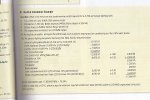I am working on a 'Neutral Calculation' Problem from
Mike Holt NEC Exam Preparation book (2008), Pg. 267.
The problem uses the 'optional method' for the single dwelling given (optional methed found in Article 220, Roman Numeral IV, starting with 220.80 and continuting with subsequent subsections of the 'optional method' for 'feeder and service load calculations').
I have attached a jpeg copy/scan of the page. Oh well, the upload snagged to a halt. Will hae to type in and upload later.
But the crux of my question is...
---Why in the solution given in the book was the 220.61(B)(1) 70% demand factor not applied in the neutral calculation ?
---And for the ungrounded conductors sizing: in light of the loads that are given for the single dwelling, how is the given 2/0 size of the ungrounded conductors arrived at ( cuz my math comes up with 130 Amps total load, which would lead to 1 AWG ungrounded conductors [either from Table 310.15.(B)(6) or from Table 310.16 ( and I don't understand why the book uses the Table 310.16 table for the ungrounded conductors of this problem anyhow. It would seem Table 310.15(B)(6) would apply, because the electrical system concerned is given to be a 'single dwelling'. )] ).
Any comment welcome. What am I missing? Thanks. ToolHound.
Mike Holt NEC Exam Preparation book (2008), Pg. 267.
The problem uses the 'optional method' for the single dwelling given (optional methed found in Article 220, Roman Numeral IV, starting with 220.80 and continuting with subsequent subsections of the 'optional method' for 'feeder and service load calculations').
I have attached a jpeg copy/scan of the page. Oh well, the upload snagged to a halt. Will hae to type in and upload later.
But the crux of my question is...
---Why in the solution given in the book was the 220.61(B)(1) 70% demand factor not applied in the neutral calculation ?
---And for the ungrounded conductors sizing: in light of the loads that are given for the single dwelling, how is the given 2/0 size of the ungrounded conductors arrived at ( cuz my math comes up with 130 Amps total load, which would lead to 1 AWG ungrounded conductors [either from Table 310.15.(B)(6) or from Table 310.16 ( and I don't understand why the book uses the Table 310.16 table for the ungrounded conductors of this problem anyhow. It would seem Table 310.15(B)(6) would apply, because the electrical system concerned is given to be a 'single dwelling'. )] ).
Any comment welcome. What am I missing? Thanks. ToolHound.
Last edited:


